ChatGPT for Marketing: How to Use AI to Save Time and Boost Results

How much time do you spend on repetitive tasks or struggling with creative block? According to HubSpot's State of Artificial Intelligence 2023 report, marketers spend up to five hours daily on administrative work, over three full working days per month.
ChatGPT helps marketers generate creative ideas, refine content marketing or copywriting processes, and act as a valuable thought partner to guide your marketing efforts. A 2024 Lightricks and American Marketing Association survey found nearly 90% of marketers use generative AI tools weekly, with ChatGPT as the top choice.
This guide covers using ChatGPT in marketing, including AI usage principles, limitations, and how DashThis's custom GPTs can streamline reporting.
Table of contents
- What is ChatGPT and how is it used in marketing?
- Essential principles for using AI tools like ChatGPT in marketing
- Limitations and best practices when using ChatGPT for marketing
- Real-world marketing use cases for ChatGPT
- How to build and analyze marketing reports with DashThis’s custom GPTs
- Save time by combining DashThis’s custom GPTs with automated reporting
What is ChatGPT and how is it used in marketing?
ChatGPT, a large language model (LLM) by OpenAI released in November 2022, brought generative AI to the public.
Notice the sharp increase in interest in OpenAI and the term generative AI after ChatGPT’s November 2022 debut. Its conversational interface and free public access made AI accessible to everyone with internet access. Now, ChatGPT has over 400 million daily users.
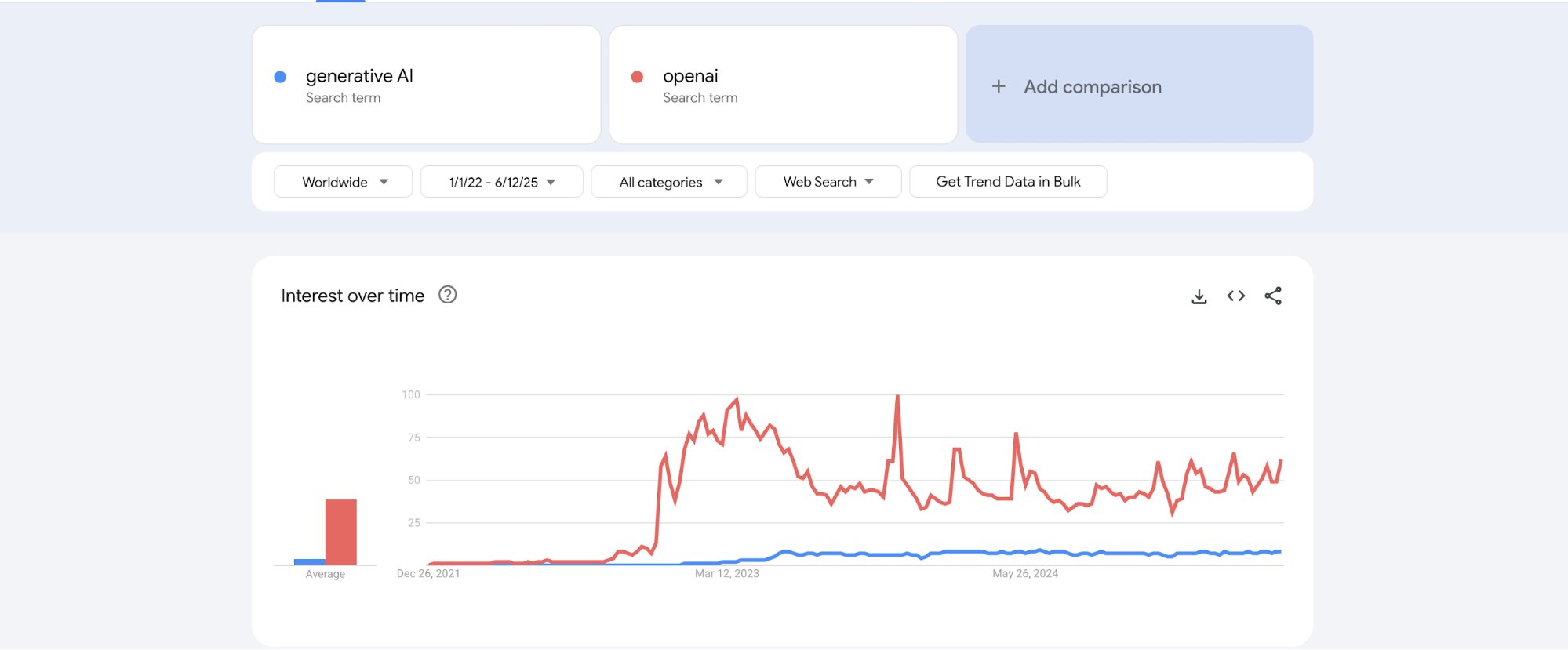
Image: Google Trends
Essential principles for using AI tools like ChatGPT in marketing
Before discussing ChatGPT’s marketing uses, it’s handy to first set context on using AI tools. Here are a few useful principles.
Know AI’s capabilities and limitations
Think of ChatGPT as your junior copywriter, research assistant, or thought partner. It’s there to handle manual work or help you generate ideas quickly to overcome writer’s block or creative fatigue.
Tests from 2023 show AI is already more creative than humans. This makes it well-suited to help you quickly generate a large quantity of ideas to get unstuck.
Before you think AI will replace you, hang on. Human input is still necessary for marketers. You need to stay in charge of strategy, judgment, brand tone, reviewing AI output, and deciding if it fits your purpose.
Understand how to prompt AI effectively
Conversational AI tools like ChatGPT work through prompts, which is how you talk to an AI to get what you want. You can ask a question or give a task.
Think of it like a Google search tailored to your needs. Unlike Google, you’re not just getting links (or ads) back. You’re getting full answers, ideas, or content created on the spot based on your prompt. But ChatGPT needs guidance to help you accomplish your goals with the necessary context and instructions.
A prompt can be a simple question like “help me come up with 5 headlines for my blog article about ChatGPT.” But for more detailed responses, explore a framework to give the AI enough information.
The CO-STAR method is a popular framework. Here’s an example of a ChatGPT prompt for an email marketer for subject line ideation.
Context: Why are you creating this prompt and what's the background situation?
"I'm an email marketer at a B2B SaaS company launching a new feature. Our open rates are declining, and I need fresh subject line ideas for our next newsletter to 15,000 subscribers."
Objective: What do you want the AI to do? Be specific.
Example prompts: "Generate 8 email subject lines to increase open rates for our new dashboard feature announcement. Focus on curiosity-driven and benefit-focused approaches, with at least 2 urgent options."
Style: How should the response be written? What profession, genre, or approach should it mimic?
Example prompts: "Write like a seasoned email marketing strategist," "Use the style of successful SaaS product launch emails," or "Mimic the approach of conversion-focused direct response copywriters."
Tone: What emotional tone or voice should the response have?
Example prompts: "Professional but approachable for B2B audiences" or "Excited and urgent for a limited-time promotion" or "Helpful and educational for nurture campaign content."
Audience: Who will read or use the response?
Example prompts: "Marketing managers at mid-size companies using analytics tools" or "Small business owners interested in social media marketing campaigns" or "C-level executives needing quick marketing performance summaries."
Response format: What output format do you want?
Example prompts: "A numbered list with brief explanations for each subject line" or "A table with columns for subject line, approach type, and predicted open rate category" or "Bullet points with A/B testing variations clearly marked."
Be ready to iterate and optimize AI output
Using the first AI response, is tempting but you can get better results with refinement. Be ready to iterate and give the AI more information. This back-and-forth helps you get more precise and helpful responses.
For example, let’s say you’re using ChatGPT to research a blog post and use the research prompt below. You’ve got a few promising results, but despite your explicit request, ChatGPT didn’t cite sources.

You can refine your approach by asking a follow-up question to ensure ChatGPT provides proper source citations.
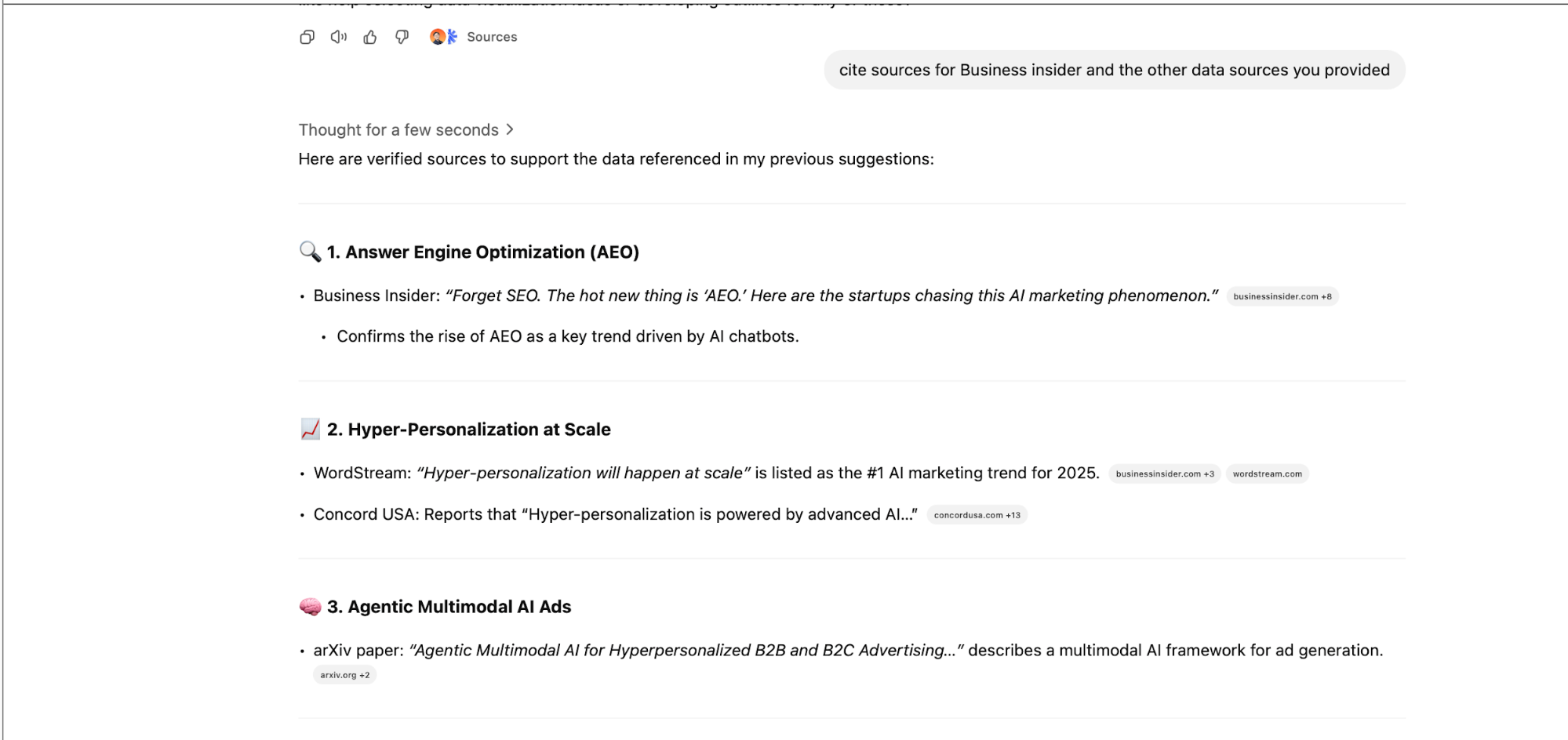
Besides refining your prompts, cross-check AI information with Google, first-hand resources, customer feedback and your personal expertise. For example, check each site ChatGPT cited to validate the link.
Limitations and best practices when using ChatGPT for marketing
Have a human check for errors in AI content
AI tools are excellent partners, but they come with one significant disadvantage - the risk of AI hallucinations. It’s when an AI makes something up and presents it as true, even though it’s not.
Even OpenAI admits there’s a risk of misinformation with its products. A 2025 OpenAI report showed their newer models hallucinate frequently. o3 made factual errors 33% of the time and o4-mini 48% of the time when summarizing facts about people.
If you don’t check your work, the reputation damage can be tremendous for your brand or agency. For example, the Chicago Sun-Times published an AI-generated summer reading list in May 2025 with nonexistent books. This went viral, resulting in significant reputational damage.
Marketing teams have faced similar issues. Recent news examples marketers should note.
- Tech outlet CNET published AI-generated content with significant factual errors
- Fashion brand Mango used AI-generated models, leading to criticisms of false advertising
In these three examples, the improper use of AI as a time-saver turned into a brand reputation crisis under scrutiny, situations any marketer wants to avoid.
Avoid obvious AI-generated content
When consumers spot obvious AI-generated content, brands face consequences. A 2025 Hookline& report found 82.1% of Americans can identify AI-written content, and 40.4% view brands more negatively for using it.
The same applies to AI usage on social media. A 2024-2025 Meltwater analysis found negative sentiment about AI-generated content nearly doubled positive sentiment (29% vs 16%). This was driven by consumer distrust and anxiety about differentiating AI-created from human-created content.

Source: Meltwater
Consider disclosing if you’ve used AI to create an image or how much you use AI in your creative process. Anthropic (makers of the AI chatbot Claude) includes an AI diligence statement on how they used AI to help create their course.
Don’t outsource your creative process to AI, and always check its output. Look for signs of AI-generated content and review your content to ensure it doesn’t resemble AI-generated work. These guidelines are a good start.
Make sure your human content includes things only humans can do. Since AI can generate general information, you need a differentiated point of view or specific personal experiences to give your content an authentic touch.
Set clear usage boundaries
Define what AI should and shouldn't do in your marketing organization, both at the company and individual levels.
Organizational guidelines: Many companies create AI usage policies to set clear rules for responsible AI use. These can be simple guidelines like "use AI to help you get started, but always have a human check the work" or detailed rules covering data privacy, disclosure, quality standards, and responsibilities.
Examples include
Personal boundaries: Set constraints to maintain creativity and quality. For writers, you can decide to use AI to only help you with brainstorming and editing, while designers can limit AI usage for image concepts only.
Quality review processes: These can include defining review processes for all AI-assisted content, ensuring it’s reviewed by a human editor (and assigning a person to oversee these checks and processes) before publication or referring to a checklist to ensure new content adheres to brand guidelines.
Real-world marketing use cases for ChatGPT
Now that we've covered the key principles and limitations of using ChatGPT in marketing, let's explore specific, actionable ways it can help with everyday marketing tasks.
For content creation and editing
Incorporate ChatGPT into your content creation process to save time or explore new angles. This applies to writing or refining a page’s meta descriptions.
Brainstorm topic ideas with ChatGPT
If your email marketing client needs fresh blog content, ask "Give me 5 blog post ideas about data-driven email automation for e-commerce email campaigns," and ChatGPT will produce creative suggestions.
ChatGPT can search the web using its basic web search or comprehensive Deep Research feature to gauge topic popularity or validate ideas with current data. Use prompts like:
- What are the top searched email marketing topics for e-commerce in 2025?
- What email automation challenges are businesses discussing online?
Contextualize these prompts for your specific audience or refine using the COSTAR format. Validate these points with your own research on Google Trends, customer research, or Exploding Topics.
Overcome writer’s block
ChatGPT can help you find the right words for your copy. Here’s how it can help you find metaphors to describe the relationship between marketing teams and AI.
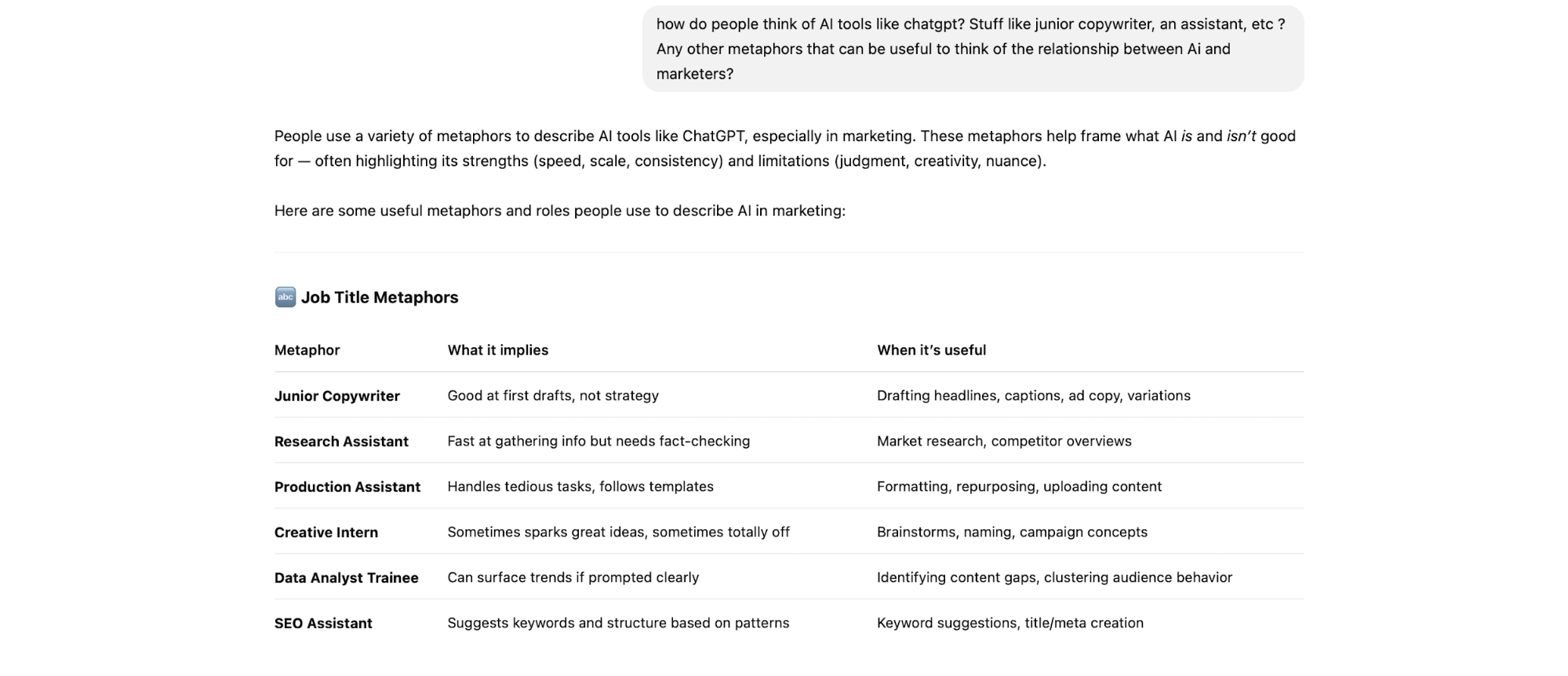
Content editing
ChatGPT can act as an editing partner. Paste your draft and request improvements. Some ideas to start:
- "Make this opening paragraph more compelling for busy executives."
- "Suggest three alternative phrasings for this value proposition."
- "Condense this email to under 150 words while keeping the main call-to-action."
Help with fact-checking
To confirm a claim during editing, ask ChatGPT a specific question like “Did I describe this statistic correctly? Refer to this link or uploaded document.”
Draft e-commerce product descriptions
ChatGPT can help you create product descriptions that are aligned with your brand voice. Try this prompt template:
“Create a 2-paragraph product description for [product name] that converts [target audience]. Use [tone] and highlight that it [main benefit]. Key features: [list 3-5 features].”
For ads and campaign planning
Brainstorm ad creatives or refine performance messaging for paid advertising campaigns
ChatGPT can quickly generate dozens of creative ideas for visuals or ad copy. To get better suggestions, give it campaign details, such as:
- What to avoid: Share what hasn't worked in previous campaigns or messaging your competitors are using.
- Target audience details: Include pain points, demographics, motivations, and current solutions to the problem you're addressing.
- Brand information: Describe your brand voice, values, and unique positioning.
- Target industry context: Include industry-specific challenges, terminology, and buying behaviors.
Then, refine the promising concepts through follow-up prompts that dive deeper into specific angles or formats.
For SEO and keyword research
Identify alternative keyword opportunities and search terms
Alongside Ahrefs or SEMRush data, ChatGPT can suggest alternative ways your target audience describes your solution for SEO planning or to refine your content marketing plan.
If you're targeting the keyword 'emergency plumber' for your landing page, ChatGPT might suggest 'urgent pipe repair,' 'after-hours plumbing help,' or '24/7 leak fix service'. These are different ways homeowners might search for the same solution.
Prompt example: I'm targeting the keyword 'emergency plumber' for my local plumbing business in [city name]. Give me 10 alternative search phrases homeowners might use for the same service during a plumbing emergency. Include urgent language, problem-focused searches, and local variations.
Search intent research
ChatGPT can describe the search intent or user goals of a keyword. Ask: "What are users trying to accomplish when they search for a keyword?"
How to build and analyze marketing reports with DashThis’s custom GPTs
While ChatGPT is useful for content creation and campaign planning, marketing reporting requires precision. With reporting, you’ll need to:
- Interpret data from multiple digital marketing platforms
- Understand marketing benchmarks and how to contextualise metrics to different platforms
- Translate performance metrics into strategic recommendations that impact client budgets and decisions.
You need to balance technical precision and industry knowledge with empathy and communication skills, while keeping your reports actionable. It’s a delicate balance.
This is where DashThis's custom GPTs can help. These specialized AI-powered assistants help marketers create reports and deliver a comprehensive client presentation.
First, sign up for a ChatGPT account. Then, access the GPTs below.
Step 1: Find the right KPIs for your marketing reports with the Report Builder Assistant
The Report Builder Assistant GPT helps you quickly identify relevant metrics based on your campaign goals and explains their importance, which is helpful in justifying your choices to clients.
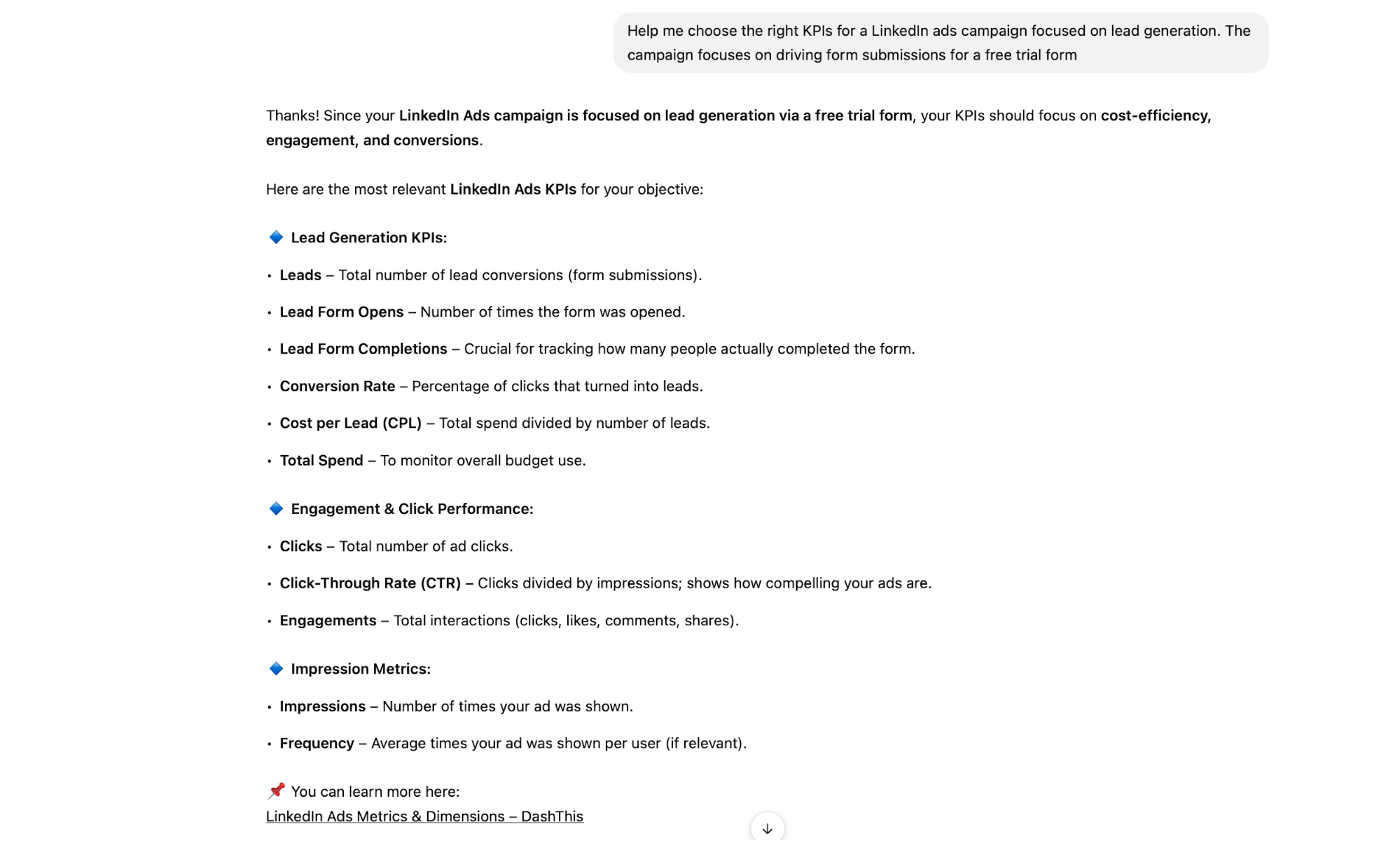
Start using this DashThis GPT with your own data
Step 2: Summarize and analyze marketing performance from a report using Data Analyst:
Use DashThis's Data Analyst for actionable campaign improvement suggestions. It works with PDF or CSV reports from any source, including Google Analytics 4, social media platforms like TikTok or LinkedIn, PPC, email marketing tools, and DashThis reports.
You’ll get a summary of key metrics, what’s working well, and areas to improve. Use this information to build your reports or identify areas needing further investigation.
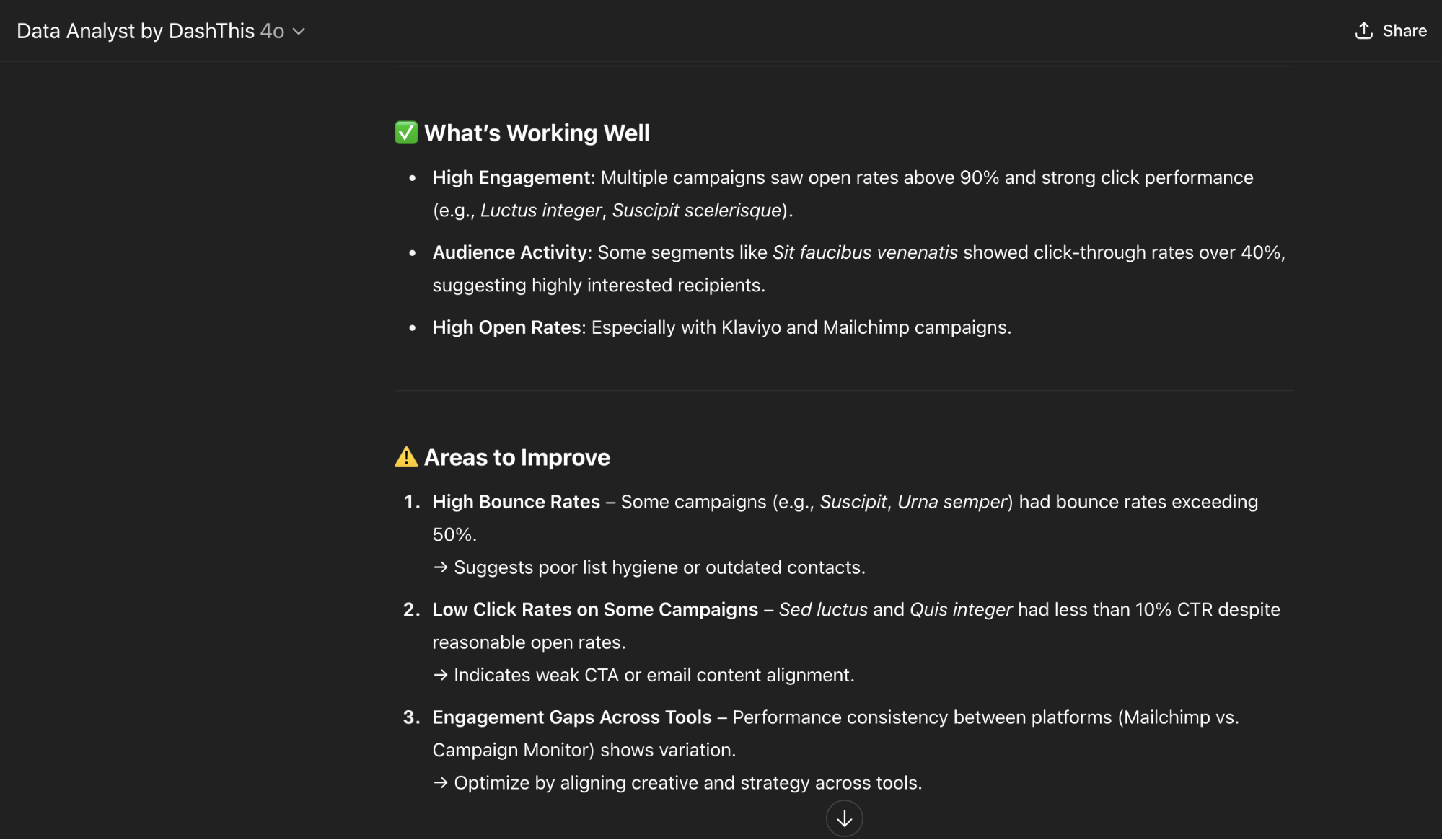
Start using this DashThis GPT with your own data
Step 3: Build persuasive client presentations with the Marketing Impact Storyteller
You have the data and analysis, but now you need to present it to your client. DashThis’s Marketing impact storyteller & presentation coach is here to help.
Think of this GPT as an assistant or coach for difficult conversations or framing your data into a cohesive presentation. Describe your campaign or upload your campaign data for specific recommendations.
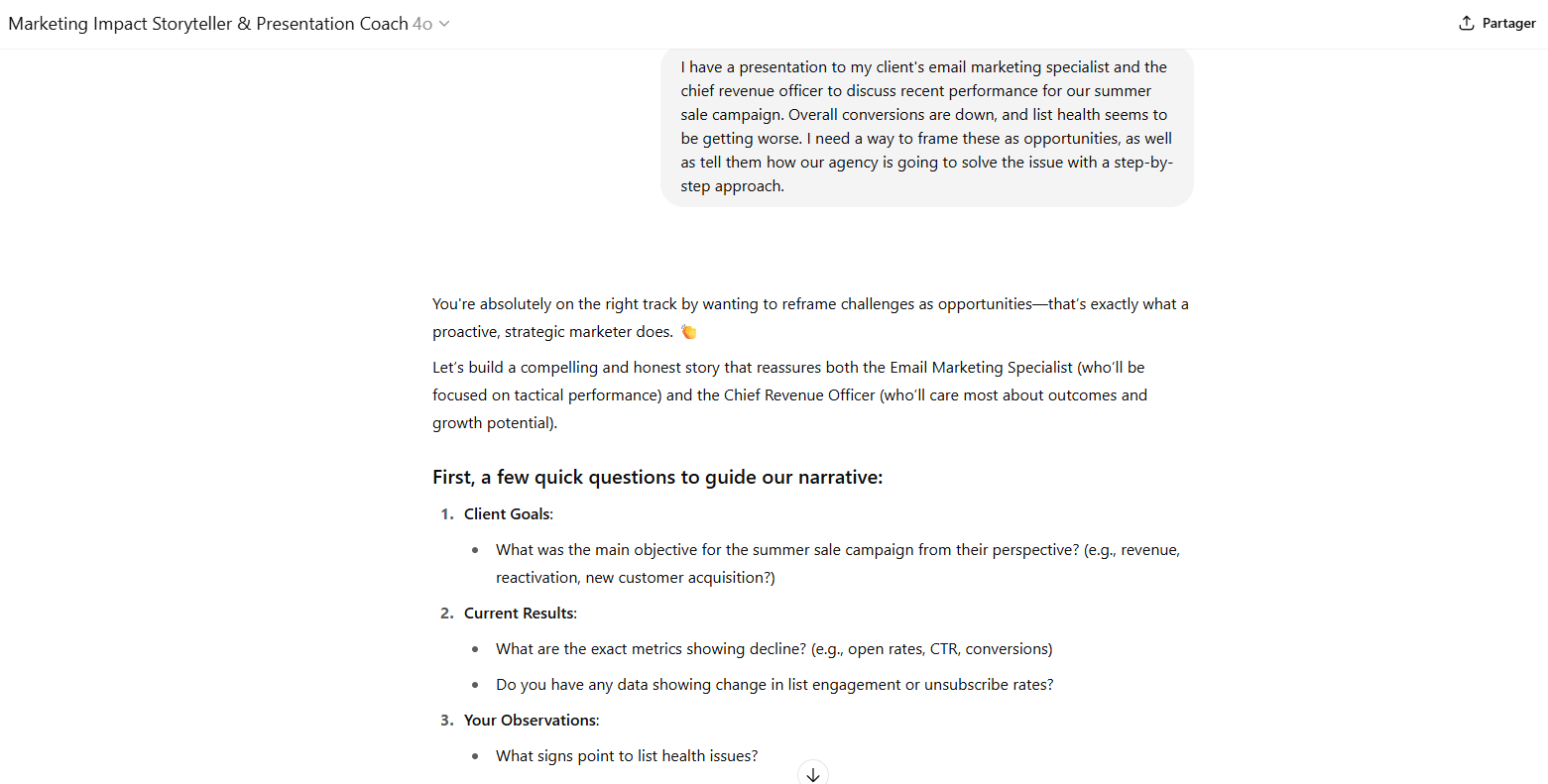
Start using this DashThis GPT with your own data
Save time by combining DashThis’s custom GPTs with automated reporting
When used purposefully, ChatGPT can help streamline marketing work and overcome creative blocks. This frees up time for strategic tasks only you can do.
DashThis's automated reporting tools save you time managing clients and streamlining reports. You can take this further by combining it with AI. Try DashThis's custom GPTs and start your 15-day free trial.
We're developing in-app AI features for automatic insights and reporting support. We're testing these features in limited beta and looking for agencies to help.
Try DashThis GPTs today and be among the first to test our upcoming AI features. Save hours on reporting and start your 15-day free trial.
Automate your reporting with Dashthis today!
Read More
Don’t miss out!
Automate your reports!
Bring all your marketing data into one automated report.
Try dashthis for free

